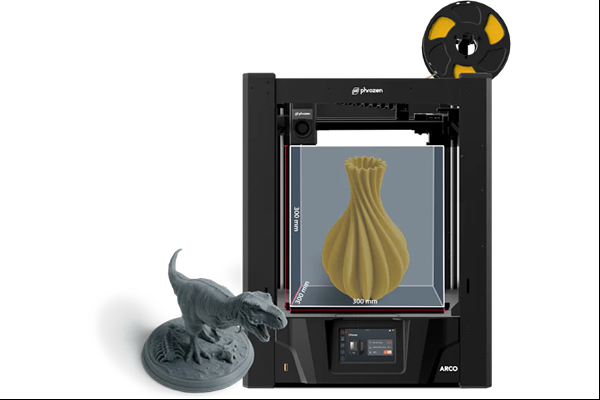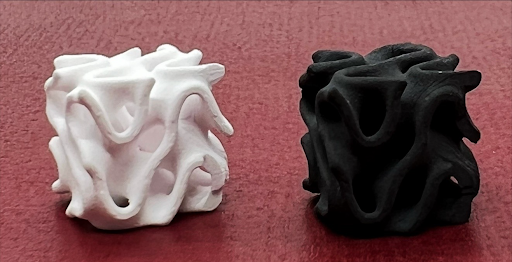In 3D Printing News Briefs today, we’re talking about an FDM 3D printer on Kickstarter, advancements in artificial eye creation, and 3D printed solenoids for electromagnets. Then we’ll move on to 3D printed guns in Canada, and finally a research award for ceramics 3D printing.
Phrozen Arco FDM 3D Printer’s Successful Kickstarter Campaign
Taiwanese 3D printer manufacturer Phrozen has long been focused on inexpensive vat polymerization systems, but recently launched an FDM 3D printer on Kickstarter. The Phrozen Arco made its debut appearance at formnext 2023, and launched on Kickstarter with a $10,000 goal. But, with just a few days left in the campaign, the material extrusion printer has raised over $1.6 million, so it’s safe to say that anticipation is high for the new Arco, which is derived from “arcobaleno,” the Italian word for rainbow. Phrozen also says that the final name of Arco can also be translated as a bow, “embodying its capabilities to propel your 3D prints with the speed and precision of a bow in the hand of a skillful archer.”
It features a 300 x 300 x 300 mm3 print volume for more convenient fabrication of large models, and can achieve acceleration up to 30,000 mm/s2 with its dual 18 mm gears and 9.5 torque ratio HGX extruder. The PIXUP Slicer software offers the ability to print multicolor models by connecting Chroma Kit AMS systems into the Arco, and the printer also features a cooling system that reduces the distance between the heat source and the gears, which helps achieve consistent extrusion performance with various materials. The new Arco also has an improved structure, with four thickened aluminum stands to enable a stable Core-XY structure and minimal wobbling. Plus, its structural design shifted weight to the bottom of the printer, which creates a low-gravity base for improved stability.
Fraunhofer IGD Advances 3D Printed Custom Prosthetic Eyes

(a) Traditionally the ocularist makes an alginate impression of the patient’s eye socket, which is used to create a wax model. (b) The wax model is inserted into the patient’s eye socket and adjusted to give the shape of the prosthesis. (c) After manufacture using PMMA the prosthesis is painted by hand using paintbrushes and coloured yarn. (d) The prosthesis shape is adjusted to be fitted to the patient during the supply visit. (e) Patient wearing the traditionally manufactured hand-made prosthesis (left eye, on the right in the image). (f) In our presented method an AS-OCT device, which is modified with a colour camera and LED lights, is used to capture the patient data. For the scan of the eye socket the ocularist selects a conformer from a set (g) which is inserted into the eye socket during the scan (h). (i) Digital model of the prosthesis, the shape and appearance are automatically created using the OCT and colour image data. (j) Multi-material 3D printed prosthesis after post-processing. (k) The shape of the prosthesis is adjusted by the ocularist during the supply where necessary. (l) Digitally designed and produced prosthesis in Patient 4, who has lost the left eye (right in the image); it provides a better or at least similar colour and appearance match for the iris and sclera compared to the manually made prosthesis (e).
Data reveals that about eight million individuals around the world use prosthetic eyes for vision restoration, but skilled craftsmanship is required to make them, which increases production time and can result in varying quality. But researchers at the Fraunhofer Institute for Computer Graphics Research (IGD) are using digital technologies to make the production of custom artificial eyes more efficient. According to their study, their goal was to create prosthetic eyes with a better fit, and more natural appearance, than what’s currently available to patients, as well as inspire more advancements in data-driven design tools and multimaterial 3D printing for other prosthetic applications, including dental restorations and facial prostheses.
The team used a prototype Casia 2 optical coherence tomography (OCT) 3D scanner to capture the eye sockets and data from ten patients. A color image of each patient’s remaining eye was captured to ensure optimal aesthetics, and the eye data was given to an AI model, which generated an accurate design that would perfectly fit the patient’s eye socket. GrabCAD software was used to upload the designs, and the full-color artificial eyes were created on a Stratasys J750 multimaterial 3D printer, using VeroVivid materials. The printing process for a single prosthetic eye was said to take just 90 minutes, and a qualified ocularist can then install it in just 15-30 minutes. The comfortable prosthetics were precisely customized to match the size, structure, and appearance of each patient’s healthy eye.
MIT Engineers Modify Multimaterial Printer to 3D Print Solenoids

MIT researchers modified a multimaterial 3D printer so it could produce three-dimensional solenoids in one step by layering ultrathin coils of three different materials. It prints a U.S. quarter-sized solenoid as a spiral by layering material around the soft magnetic core, with thicker conductive layers separated by thin insulating layers. Credit: Massachusetts Institute of Technology
We’re not quite to the point where we can manufacture electronic devices using only 3D printing, but an MIT research team has brought us one step closer with its ability to create fully 3D printed solenoids, which form the basis of many electronics, including dishwashers and dialysis machines. Solenoids are electromagnets formed by a coil of wire wrapped around a magnetic core, and generates a magnetic field when an electrical current is passed through it. Because a solenoid is made by coiling thin layers of multiple materials, the team modified a commercial, multimaterial extrusion 3D printer—the E3D Motion System and ToolChanger—so it could print smaller, magnetic-cored solenoids in one step.
The four-nozzle printer was retrofitted so one nozzle could extrude magnetic nylon pellets, and the researchers added ventilation to cool the conductive material so it wouldn’t melt and jam the nozzle. The printer can produce a solenoid that’s about 33% smaller than other 3D printed ones by layering thicker conductive layers, separated by thin insulating layers, around the soft magnetic core. This increased the number of coils in the solenoid, which enables it to withstand twice as much electric current, and generate a magnetic field three times larger than other 3D printed devices are able to achieve. The customized 3D printer, even with the additional modifications, cost about $4,000, which is less expensive than some other approaches. The researchers are looking into other modifications, including how to more precisely control the temperature the material is deposited at to reduce defects, and using materials with better properties. You can learn more about this work in the team’s published paper.
Edmonton Police Report First Major Seizure of 3D Printed Guns

Prohibited semi-automatic firearms (left) and privately manufactured firearms seized from Edmonton-area home in June 2023. On display at Edmonton police press conference Feb. 28, 2024. (Darcy Ropchan, CityNews)
The Edmonton Police Service (EPS) in Alberta, Canada reported a “sophisticated” 3D printed guns operation in a man’s home, and said its scale could mean that Roy Evan Tucker, now 29, was preparing to traffic the guns. The EPS guns and gangs section says it’s the city’s first “significant seizure” of ghost guns, and that they were alerted by Quebec provincial police this summer that Tucker was buying parts from a supplier in Montreal meant specifically for 3D printed firearms. This is what led to a search of his home, where police say they found three loaded handguns; 16 privately manufactured Glock-style handguns; a privately manufactured steel firearm; 27 high-capacity magazines; a homemade suppressor; a commercial-grade 3D printer and firearm blueprints; and two prohibited semi-automatic firearms believed to have been smuggled from the U.S.
Tucker was recently charged with 43 offenses related to firearms manufacturing, including possession of a firearm knowing its possession is unauthorized; firearms trafficking; possession for the purpose of firearms trafficking; and possession of prohibited/restricted firearms. According to investigators with Project Reproduction—the national investigation into privately manufactured firearms—guns like these that people can make at home “are a trend that’s getting worse.” Staff Sgt. Eric Stewart with the EPS guns and gangs section said that they seized 38 3D printed or privately manufactured guns in 2022, while 88 were seized in 2023.
NSF Career Award Given to Professor for 3D Ceramics Research
Chao Ma, an associate professor of manufacturing engineering in the Ira A. Fulton Schools of Engineering at Arizona State University, received a $600,000 National Science Foundation (NSF) Faculty Early Career Development Program (CAREER) Award for his work in using binder jet additive manufacturing, or BJAM, to enhance the manufacturing capabilities of ceramics. Ceramics are used as catalysts for creating new materials in chemical, energy, and environmental sectors, and Ma, a faculty member in the School of Manufacturing Systems and Networks, is researching a new method to regulate the density of BJAM 3D printed ceramic objects in order to improve the quality of the material. He believes that granule characteristics can affect compaction behaviors, which would enable density control of ceramic parts, and his work could reveal a complex relationship between some parameters and the finished material structure.
“BJAM will allow the production of ceramic products in almost any shape. This geometric flexibility will make it possible to manufacture products customized for use with higher quality,” Ma said.
“My approach combines a tailored feedstock powder and an emerging powder bed formation method to control the density.”
Subscribe to Our Email Newsletter
Stay up-to-date on all the latest news from the 3D printing industry and receive information and offers from third party vendors.
You May Also Like
3D Printing Webinar and Event Roundup: April 21, 2024
It’s another busy week of webinars and events, starting with Hannover Messe in Germany and continuing with Metalcasting Congress, Chinaplas, TechBlick’s Innovation Festival, and more. Stratasys continues its advanced training...
3D Printing Webinar and Event Roundup: April 14, 2024
We’re starting off the week’s 3D printing webinars and events at ASTM AMCOE’s 11th Snapshot Workshop and MACH Exhibition. Stratasys continues its advanced training courses, SME is holding a virtual...
Polly the Duck to Receive 3D Printed Bill Prosthetic
In Williamson County, Texas, a story of resilience, innovation, and cross-community effort is unfolding, illustrating the bond between humans and wildlife. All Things Wild, a wildlife rehabilitation center, has been...
Tinkering for Change: 12th Grader’s Universal Fit 3D Printed Prosthetic at 2024 Regeneron Competition
This year’s Regeneron Science Talent Search (STS), the nation’s oldest and most famous science competition, has brought 40 candidates into the limelight, all competing for $1.8 million in prizes. Now...


































